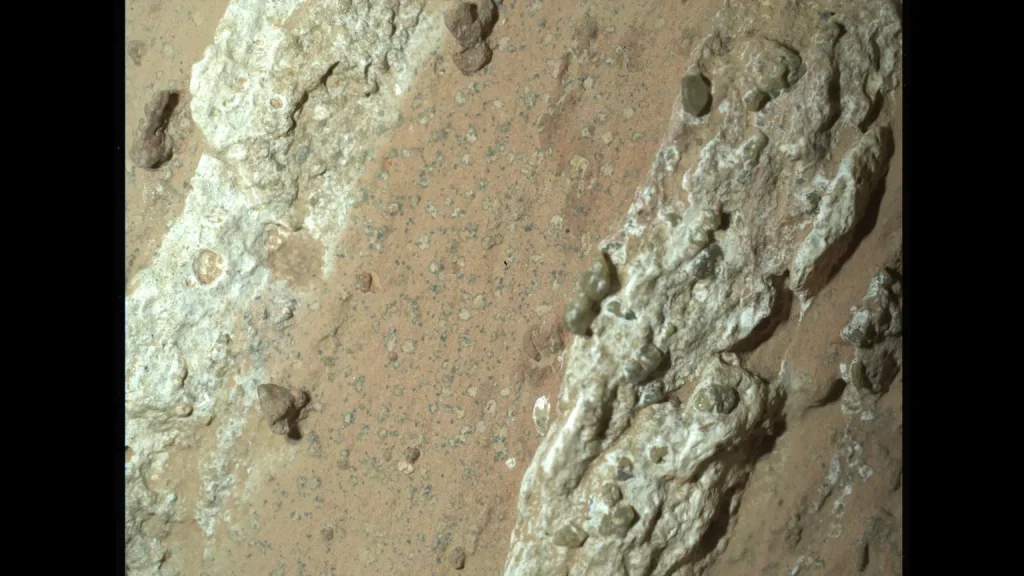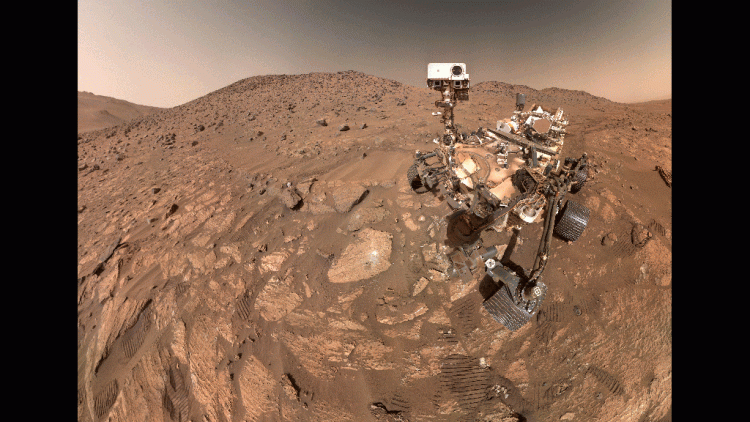Introduction
On Mars, where the surface is a canvas of rust-colored dust and rugged terrain, NASA’s Perseverance rover is making groundbreaking discoveries that promise to reshape our understanding of the Red Planet. One of the most intriguing finds of this mission is a distinctive rock formation that has captivated scientists and fueled excitement about the potential for past life on Mars. This article delves into the details of this remarkable discovery, the Perseverance rover’s mission, and the broader implications for Martian science.
The Perseverance Rover Mission: An Overview
1. Mission Objectives
Launched on July 30, 2020, as part of NASA’s Mars 2020 mission, the Perseverance rover represents a significant leap in Mars exploration. Its primary objectives include:
- Search for Signs of Past Life: Perseverance is designed to search for evidence of ancient microbial life by studying Mars’ geology and climate.
- Collect Martian Samples: The rover aims to collect and cache samples of Martian rock and regolith for future return to Earth.
- Test New Technologies: Perseverance is testing new technologies, including the Ingenuity helicopter, which aims to demonstrate powered flight on another planet.
- Understand Mars’ Climate and Geology: By analyzing rock formations and soil, Perseverance seeks to understand the planet’s past climate and geological history.
2. Rover Design and Capabilities
Perseverance is equipped with a suite of advanced scientific instruments and engineering innovations:
- SuperCam: This instrument analyzes the composition of rocks and soil from a distance using a laser.
- MastCam-Z: A camera system with high-resolution imaging capabilities that provides detailed views of the Martian surface.
- PIXL (Planetary Instrument for X-ray Lithochemistry): A tool for identifying the elemental composition of rocks and soil.
- SHERLOC (Scanning Habitable Environments with Raman & Luminescence for Organics and Chemicals): Analyzes organic molecules and minerals associated with potential life.
- MOXIE (Mars Oxygen In-Situ Resource Utilization Experiment): Demonstrates the production of oxygen from Martian CO2.
Discovery of the Intriguing Martian Rock
1. The Context of the Discovery
In early 2024, Perseverance’s scientific team identified a particularly unusual rock formation in the Jezero Crater, a location selected for its ancient lakebed and delta features. The rock stood out due to its unique appearance and composition, which differed significantly from the surrounding geological materials.
- Location: The discovery was made in the western region of Jezero Crater, an area known for its diverse rock types and mineral deposits.
- Rock Characteristics: The rock featured intricate patterns and structures, suggesting complex geological processes. Its coloration, texture, and layering intrigued scientists, prompting further investigation.
2. Scientific Analysis and Findings
The initial analysis of the rock provided several intriguing insights:
- Composition: Using the PIXL and SuperCam instruments, scientists determined that the rock contains an unusual mix of minerals, including high concentrations of specific silicates and carbonates. This composition indicates a potentially different formation environment compared to nearby rocks.
- Texture and Structure: Detailed imaging revealed complex textural patterns, including vesicles and potential fossil-like structures. These features suggest that the rock may have formed from volcanic or sedimentary processes.
- Historical Significance: The rock’s composition and structure may provide clues about Mars’ ancient environment. If the rock formed in the presence of water, it could offer valuable information about the planet’s habitability.
Implications for Mars Science
1. Insights into Mars’ Geologic History
The discovery of this rock offers new perspectives on Mars’ geological history:
- Volcanic Activity: If the rock is volcanic in origin, it could provide insights into Mars’ volcanic history and the nature of past eruptions. Understanding volcanic activity on Mars helps scientists infer the planet’s internal dynamics and thermal evolution.
- Sedimentary Processes: Alternatively, if the rock is sedimentary, it may reveal details about past water flow and sediment deposition. This information is crucial for reconstructing the ancient climate and environment of Mars.
2. Potential for Past Life
One of the most exciting aspects of the discovery is the potential for past microbial life:
- Habitability Indicators: The presence of carbonates and other minerals associated with water could indicate that the rock formed in conditions favorable for life. This discovery could suggest that the Jezero Crater region was habitable in Mars’ distant past.
- Biological Signatures: The intricate patterns and structures observed in the rock could be interpreted as potential biosignatures. While it is too early to confirm the presence of life, these findings warrant further analysis and investigation.
3. Future Exploration and Sample Return
The discovery has significant implications for future exploration missions:
- Sample Collection: Perseverance is designed to collect and cache samples from interesting rock formations, including the newly discovered rock. These samples will be analyzed in detail on Earth by future missions, providing a deeper understanding of their composition and potential biological significance.
- Sample Return Mission: NASA’s plans for a sample return mission aim to bring Martian samples back to Earth, where they will be examined using advanced laboratory techniques. This mission will be critical for confirming the presence of past life and understanding Mars’ history.
Broader Context of Mars Exploration
1. Historical Achievements in Mars Exploration
The Perseverance mission builds on a rich history of Mars exploration, including:
- Mariner Missions: NASA’s Mariner missions in the 1960s and 1970s provided the first close-up images of Mars, revealing its surface features and atmosphere.
- Viking Landers: In the 1970s, the Viking landers conducted the first successful landing on Mars and performed experiments to search for signs of life.
- Rovers and Landers: Missions like Spirit, Opportunity, Curiosity, and InSight have explored Mars’ surface and provided valuable data on its geology, climate, and potential for life.
2. The Role of International Collaboration
Mars exploration is a collaborative effort involving international space agencies and scientific organizations:
- ESA and Roscosmos: The European Space Agency (ESA) and the Russian space agency Roscosmos have contributed to Mars exploration through missions like the Mars Express orbiter and the ExoMars rover.
- International Science Community: Researchers from around the world collaborate on Mars science, sharing data and findings to advance our understanding of the planet.

Challenges and Opportunities in Mars Exploration
1. Technical Challenges
Exploring Mars presents several technical challenges:
- Distance and Communication: The vast distance between Earth and Mars results in communication delays, making real-time data transmission difficult. This requires careful planning and autonomous operations for rover missions.
- Surface Conditions: Mars’ harsh surface conditions, including extreme temperatures and dust storms, pose challenges for rover durability and performance. Engineers must design robust systems to withstand these conditions.
2. Scientific Opportunities
Despite these challenges, Mars exploration offers numerous scientific opportunities:
- Uncovering Mars’ Past: Each new discovery on Mars provides a piece of the puzzle in understanding the planet’s history. From ancient lakes to volcanic activity, these findings contribute to a comprehensive picture of Mars’ evolution.
- Preparing for Human Exploration: The knowledge gained from current missions will inform future human exploration of Mars. Understanding the planet’s environment, resources, and potential hazards is crucial for preparing for crewed missions.
Public Engagement and Education
1. Inspiring the Next Generation
Mars exploration captures the public’s imagination and inspires future generations:
- Educational Programs: NASA and its partners develop educational programs and resources to engage students in space science. These programs include interactive tools, curriculum materials, and outreach activities.
- Public Communication: NASA’s Mars missions are communicated through various media channels, including social media, websites, and public lectures. These efforts help raise awareness and foster interest in space exploration.
2. Citizen Science and Participation
Public involvement in Mars exploration is encouraged through citizen science initiatives:
- Image Analysis: NASA occasionally invites the public to participate in analyzing images from Mars rovers. These initiatives provide valuable data and engage citizens in scientific discovery.
- Educational Outreach: Public lectures, workshops, and virtual events provide opportunities for individuals to learn about Mars exploration and contribute to scientific discussions.
Looking Ahead: The Future of Mars Exploration
1. Upcoming Missions
Several upcoming missions are planned to further explore Mars:
- Mars Sample Return: NASA and ESA are working on a mission to return Martian samples to Earth, providing detailed analysis of Martian rocks and soil.
- Human Exploration: NASA’s Artemis program and future Mars missions aim to prepare for crewed exploration of the Red Planet. These missions will build on the knowledge gained from robotic explorers.
2. Ongoing Research and Discoveries
The Perseverance rover and other Mars missions will continue to provide valuable data:
- Data Analysis: Ongoing analysis of Mars rover data will yield new insights into the planet’s geology, climate, and potential for life.
- Scientific Collaboration: Researchers worldwide will continue to collaborate on Mars science, sharing discoveries and advancing our understanding of the Red Planet.


















































Discussion about this post